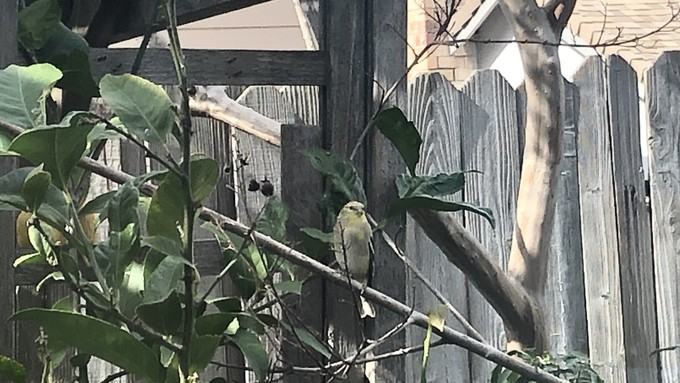
Great Backyard Bird Count can be done in parks or nature areas as well as at home

Whether it involves spotting lesser goldfinches in your backyard, as above, or myriad birds in a nearby wildlife site, anyone can participate this weekend in the Great Backyard Bird Count. Kathy Morrison
Got 15 minutes to spare for the birds? The Great Backyard Bird Count is back.
Starting Friday and through this holiday weekend, anyone can help contribute to a real-time snapshot of bird populations.
The National AudubonSociety naturally is involved in the event, and explains it like this:
“Participants are asked to count birds for as little as 15 minutes (or as long as they wish) on one or more days of the four-day event and report their sightings online at birdcount.org. Anyone can take part in the Great Backyard Bird Count, from beginning bird watchers to experts, and you can participate from your backyard, or anywhere in the world.”
How to participate? Here’s the guide from birdcount.org (also available at the link):
1) Count birds anywhere you like for at LEAST 15 minutes – or for as long as you wish. Keep track of the kinds of birds you see and how long you watched.
2) Make your best estimate of how many birds you saw of each species. For example, 5 Northern Cardinals, 3 American Crows. Huge flocks may be a challenge, but your best guess is still valuable.
3) Enter your list(s) online at www.birdcount.org. Put in a new checklist:
– for each new day
– for each different location
– for the same location, same day, if you counted at a different time of day.
The observation data are used by ornithologists to learn how birds are doing overall and how to protect them and the environment we all share.
Gardeners of course depend on birds to control insect pests as well as contribute to the diversity and beauty of our outdoor world.
If you’re not already familiar with the birds in your neighborhood, I recommend downloading the free Merlin app today, or at least before you start counting. (The account you create will be used to file your bird-count checklist, too.) Merlin was created by the Cornell Lab of Ornithology to help anyone identify, by photo or by sound, the birds around them. You can download a list of birds common to the western United States. I especially like to record on my phone the call or song of a bird I can’t see.
The Sacramento Audubon Society also maintains an online list of Sacramento-area birds, which is so helpful in learning all the feathered neighbors.
Birdcount.org also has excellent tips on identifying and counting birds.
You can be sure I'll be out in the wilds of my backyard Friday, with binoculars and phone at ready.
Comments
0 comments have been posted.Sacramento Digs Gardening to your inbox.
Sites We Like
Garden Checklist for week of May 12
Get your gardening chores and irrigation done early in the day before temperatures rise.
* Plant, plant, plant! It’s prime planting season in the Sacramento area. Time to set out those tomato transplants along with peppers and eggplants. Pinch off any flowers on new transplants to make them concentrate on establishing roots instead of setting premature fruit.
* Direct-seed melons, cucumbers, summer squash, corn, radishes, pumpkins and annual herbs such as basil.
* Harvest cabbage, lettuce, peas and green onions. This heat will cause leafy greens and onions to flower; pick them before they bolt.
* In the flower garden, direct-seed sunflowers, cosmos, salvia, zinnias, marigolds, celosia and asters.
* Plant dahlia tubers. Other perennials to set out include verbena, coreopsis, coneflower and astilbe.
* Transplant petunias, marigolds and perennial flowers such as astilbe, columbine, coneflowers, coreopsis, dahlias, rudbeckia and verbena.
* Keep an eye out for slugs, snails, earwigs and aphids that want to dine on tender new growth.
* Feed summer bloomers with a balanced fertilizer.
* For continued bloom, cut off spent flowers on roses as well as other flowering plants.
* Got fruit trees? If you haven't already done so, thin orchard fruit such as apples, peaches, pears, pluots and plums before they grow too heavy, breaking branches or even splitting the tree. Leave the largest fruit on the branch, culling the smaller ones, and allow for 5 to 6 inches (or a hand's worth) between each fruit.
* Thin grape bunches, again leaving about 6 inches between them. For the remaining bunches, prune off the "tail" end, about the bottom third of the bunch, so that the plant's energy is concentrated in the fruit closest to the branch.
* As spring-flowering shrubs finish blooming, give them a little pruning to shape them, removing old and dead wood. Lightly trim azaleas, fuchsias and marguerites for bushier plants.
* Add mulch to the garden to help keep that precious water from evaporating. Mulch also cuts down on weeds. But don’t let it mound around the stems or trunks of trees or shrubs. Leave about a 6-inch to 1-foot circle to avoid crown rot or other problems.